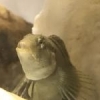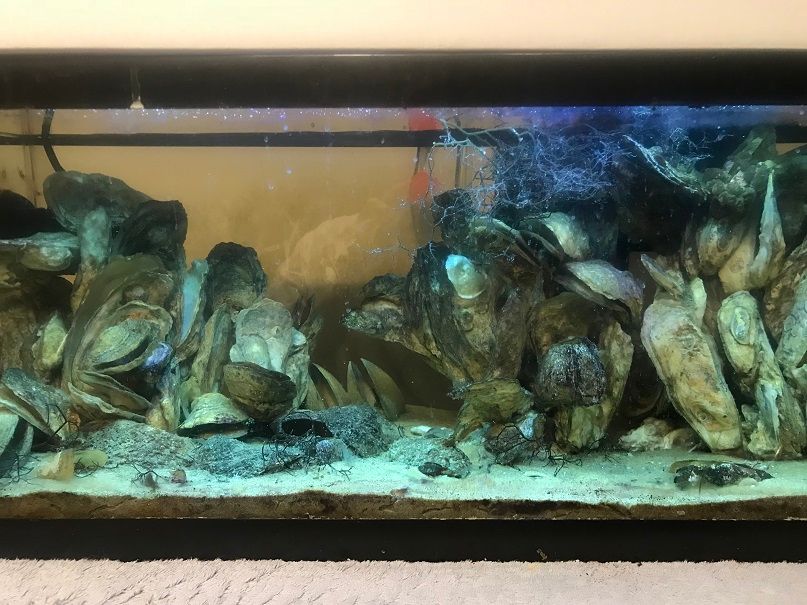Ever since I set up this tank, off and on, some of the fish have shown signs of parasitism, in particular, scratching themselves on the oyster shells or substrate. Until recently, mostly the gobies have been doing it, with a blenny doing it once in a rare while. But now, All of the gobies and several of the blennies have been scratching much more frequently. And, three of the blennies have visible signs of parasitism or disease of some sort, mainly a loss of overall color on their sides (faded, a bit whitish but not solid white), and on Friday, I noticed one of the blennies frequently cowering in the corner, which is another sign of disease (and I'll add a but...later), and, this blenny is showing some cysts (like ich, larger, so I don't think it is velvet) around the head. It is a male blenny, and has also been biting his tail, as if to attempt to remove something. I also noticed my largest male with similar symptoms, and he would only show up for a few bites of food, then hide again. Only a couple blennies didn't show any symptoms, and neither did any of the skilletfish. All of the fish ate well, even showing up to feed out of my hand (which is comical as I try and spread the food around the tank, skilletfish and blennies chase my hand and try to intercept the food from my fingers). So, I don't think I'm too late.
So, I had to take action, not wanting what happened to my other tank where all of the fish died. I suspected flukes and/or ich. I set up a 20g long quarantine tank and began the process of catching my fish for treatment. Well, as you might suspect, blennies, gobies and skilletfish aren't ones to come to the net. So, remove all of the cover (my oyster reef and shells) and left the invertebrates in the tank. It took me quite a while to coax the blennies and skilletfish out of the many hiding spots in the oyster cultches. Some of the fish were in the individual oyster shell (matching pairs, connected and open). And, within one of those shells was my largest male that was always hiding except for food, and infected with the disease. And in his shell, were eggs.
MY FISH WERE BREEDING! He was guarding eggs, hence, the reason that he wasn't coming out for food. It also might have been part of the reason that the other large male was cowering in the front corner of the tank. So, this is great, because it was a goal of mine to breed these fish, but, at the same time, it stinks because I had to remove them from the display tank.
After setting up my quarantine tank treated with Cuprimine (a copper medication) to kill ich and/or velvet, I brought the fish in and gave each of them a freshwater dip for 5 minutes. I was happy to see that this didn't stress out the fish much at all, and after each one, put them in the QT. I noticed some external parasites falling off, but the main reason to do the dip was to look for flukes. There may have been a few, but, not many at all, and certainly not enough to cause a fish to be sick and stressed. There may have been a bunch of smaller parasites that I couldn't either see or ID with my magnifying glass. So, maybe that wasn't a total bust, because FW dips can provide some relief of the symptoms, albeit temporary.
So, this is day three of QT and they are now being treated with a full dose of copper. 27 days to go. The display tank is fallow, save for the invertebrates, and will remain fallow for 6 weeks. After the QT period is up, I'll keep the fish in there for observation until they are ready to go back into the DT.
A friend of mine suggested a possible bacterial infection, so if the whitish film doesn't go away, I will try treating them with antibiotic. Anyone know if I can use antibiotics and copper at the same time?
Once I'm done with this process, then the QT tank will remain my QT tank for future collections. I plan to use the other 20g tank as a holding tank for any new macroalgae, invertebrates, substrate or shells that I collect for my display tank, with the idea that keeping them in observation for 6 weeks serves the same purpose as keeping a tank fallow, to make sure that they are parasite free for the most part.
Until then, it will be a challenge to control ammonia and nitrites for a few days while keeping the dose of copper at the most effective level. I took out a sponge filter from my other tank to aid in the cycling of the QT. The QT has a bunch of PVC pipe pieces and parts for the fish to hide in, and they're taking to them. They're scared to death of me now, understandably, and also very spooky. They don't like their new home much at all, but, they are eating. I reduced their feeding to once per day and half of what I've been feeding them until the QT cycles.












